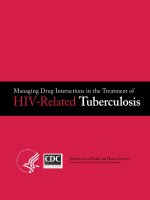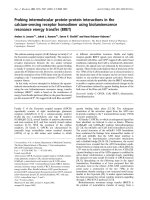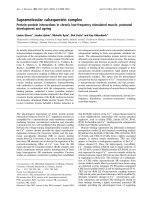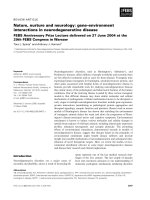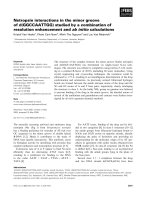- Trang chủ >>
- THPT Quốc Gia >>
- Hóa
Interactions in ecosystems
Bạn đang xem bản rút gọn của tài liệu. Xem và tải ngay bản đầy đủ của tài liệu tại đây (3.99 MB, 12 trang )
Life Sciences
Standards
Preview
3.c. Students know many plants
depend on animals for pollination and
seed dispersal, and animals depend on
plants for food and shelter.
Standard Set 3. Life Sciences
3. Living organisms depend on one
another and on their environment for
survival. As a basis for understanding
this concept:
3.b. Students know that in any
particular environment, some kinds of
plants and animals survive well, some
survive less well, and some cannot
survive at all.
Genre
Nonfiction
by Martin E. Lee
Comprehension Skill
Cause and Effect
Text Features
•
•
•
•
Captions
Diagrams
Call Outs
Glossary
Science Content
How Living Things
Survive
Scott Foresman Science 4.5
ISBN 0-328-23553-9
ì<(sk$m)=cdf dh< +^-Ä-U-Ä-U
Vocabulary
adaptation
community
competition
pollination
population
seed dispersal
Interactions
in Ecosystems
Picture Credits
Every effort has been made to secure permission and provide appropriate credit for photographic material. The
publisher deeply regrets any omission and pledges to correct errors called to its attention in subsequent editions.
Unless otherwise acknowledged, all photographs are the copyright of Dorling Kindersley, a division of Pearson.
ISBN: 0-328-23553-9
Copyright © Pearson Education, Inc. All Rights Reserved. Printed in the United States of America.
This publication is protected by Copyright, and permission should be obtained from the publisher prior to any
prohibited reproduction, storage in a retrieval system, or transmission in any form by any means, electronic,
mechanical, photocopying, recording, or likewise. For information regarding permission(s), write to
Permissions Department, Scott Foresman, 1900 East Lake Avenue, Glenview, Illinois 60025.
1 2 3 4 5 6 7 8 9 10 V010 13 12 11 10 09 08 07 06
by Martin E. Lee
What determines
survival?
Competition
All of the owls that live in an area make up a
population. A population is all of the same kind of
living things that live in one place. All of the different
populations in that place make up a community.
Animal populations may hunt together, travel
together, and protect each other. But their environment
might not have enough resources. Competition
happens when living things must use the same limited
resources. Owls compete for food, shelter, and places to
hunt. Mice compete for food and shelter from owls.
Plants also compete to stay alive. Many seedlings
may sprout close together. But only a few grow into
mature plants. This is because there is not enough
space for all of them. Taller plants get more sunlight
than shorter plants do. This allows them to make more
of their own food through photosynthesis. Their shorter
neighbors in the shade may not be able to survive.
Different populations in a community might
compete. Snakes, owls, and mice all share an area.
The owls and snakes must compete for the same
population of mice.
This mistletoe competes
with other plants by taking
resources from the tree.
Owls compete with other
animals for food sources
such as mice.
2
3
Sharing Resources
A Varied Diet
Both owls and hawks feed on the same kind of prey.
Hawks do their hunting by day. Owls hunt at night.
This reduces competition between hawks and owls.
Symbiosis is two living things needing each other to
live. One kind of symbiosis is with lichens. Lichens are
fungi and algae. Algae supply food for the fungi. Fungi
give algae water and protect them from sunlight.
Symbiosis between living things can sometimes
help one while it hurts the other. The organism that is
helped is called a parasite. The one that is hurt is called
the host. The mistletoe on page 3 is a parasite. The tree
is a host.
Animals eat other living things to get the energy
they need. Some animals compete by eating different
kinds of food. Black bears eat in this way. They eat
whatever they can find at different times of the year.
Black bears eat grasses and meadow plants in the
spring. All summer they claw into logs and stumps for
insects. They eat pine cones, acorns, berries, and nuts
in late summer and fall. They also eat fish. Bears will
even eat trash left out by humans if they can get at it.
Black bears sleep for much of
the winter. In the spring they
eat young plants and grasses.
California’s black bears hunt
for salmon in the late summer.
4
5
Claiming and Defending Territory
Many animals compete for territory. Territory is
an area where an animal finds its food and water. It
provides space for living and raising young. Territory
helps animals get the resources they need.
Animals do many things to claim and defend their
territory. Male crickets sing loudly and fight each other
for territory. Male butterflies defend where they perch.
Mammals, including male bighorn sheep, elk, and
deer, will crash their horns or antlers together to
compete for territory. This also helps them
attract mates. Skunks spray a smelly
substance on animals that get too
close. The bad smell works!
Birds also have many behaviors for claiming or
defending their territory. They may strut or sing. Or
they will spread their wings wide. This makes them
look threatening.
The avocet is a shore bird. Avocets work together to
protect their nesting areas. They make loud noises and
rush away from the nest. Such behavior may distract
predators.
This red-winged blackbird is
singing and spreading his wings
wide to defend his territory.
An avocet spreads its wings as
wide as possible. This scares
away predators.
6
Plants Compete for Resources
The desert has many creosote
plants. Creosote plants seem to
“claim” territory that other plants
cannot survive in. Their wide,
shallow root system helps them
soak up water quickly. They soak
up so much water that other
plants cannot grow!
7
How do
environmental
changes affect living
things?
An adaptation is a trait that helps an organism
survive in its environment. Color change is an
adaptation. In spring, the feathers of birds called
white-tailed ptarmigan are gray or brown. They
blend in with plants. In winter, these birds have white
feathers. They are able to blend in with snow and ice.
A change in the environment can cause problems
for living things. Many birds migrate to California salt
marshes. But people have drained or built over most
of these marshes. This has reduced space for migrating
birds. This makes it harder for birds to survive.
A ptarmigan’s feathers change colors with
the seasons. This makes it harder to see.
8
Flippers, smooth
skin, and a
tail fluke are
adaptations that
help whales
swim.
Blubber is a thick layer of fats
and oils under a whale’s skin.
This adaptation keeps whales
warm in cold water.
Whales’ Adaptations
Whales are adapted to life underwater. Along with
the adaptations shown in the picture, whales also
have a special way to feed. They push seawater out of
their mouths through plates called baleen. Baleen is
like a filter. It traps tiny living things called plankton.
Plankton are the whale’s main food. One of the largest
animals in the world survives by eating tiny sea life!
9
How Plants Survive
Plants also have adaptations that help them
survive. Pine trees have thin waxy leaves, also called
needles. Pine needles do not lose much water. Some
plants’ leaves or thorns are poisonous. This protects
them from animals that would eat them.
Pollination is the movement of plant pollen from
a male part of a flower to a female part. Birds, bats,
and insects help flowers pollinate. They move the
pollen as they feed on the plants. Bright flowers and
sweet smells are helpful adaptations for plants. They
attract the animals that pollinate.
Skunk cabbage grows in shade
in moist forests. Its large leaves
help it take in light.
These plants’ bright colors are an
adaptation. So are their thick leaves
and stems.
Plants often change as the weather
changes. In winter, many plants stop using
sunlight to make food. Their leaves turn brown
and drop off. Some plants can store food in their
roots, stems, seeds, or fruits. These adaptations
allow the plant to survive winter. When spring
returns, they can grow again.
Plants compete for sunlight, water, nutrients, and
living space. In a group of the same kind of plant,
some plants will get more nutrients than others. This
helps them grow taller. Taller plants will get more
sunlight. This helps them make more food.
10
11
How do animals
depend on plants?
Food and Other Substances
Animals would starve without plants. Some
animals do not eat plants. But they get energy by
eating animals that eat plants.
Animals live where they can find the plants they
eat. Monarch butterfly caterpillars eat only milkweed
plants. Many caterpillars spend the winter in parts of
California. Milkweed is easy to find in those areas.
Milkweed plants contain a chemical. The chemical
enters the monarch’s body as it
eats. This chemical tastes
bad or even poisons other
animals. But it protects
the butterfly. Other
animals learn not to eat the
butterfly.
Some animals get other things they need by eating
plants too. Some desert animals survive by getting
water from plants.
Oxygen
You have read that plants use energy from sunlight.
They use the energy with water and carbon dioxide to
make their own food. Plants also make oxygen when
they make food. They release the oxygen into the air.
This oxygen is important to all living things. People
and other living things must have oxygen. Oxygen
helps living things get energy from the food they eat.
This sheep would starve if the grass died out.
It depends on grass for energy.
This monarch butterfly
caterpillar gets its food from
milkweed plants.
12
13
Shelter and Materials
Plants and People
Animals also use plants for shelter. Some insects
stay protected by looking like part of a plant. Many
animals in tropical rain forests live in the trees their
whole lives. This helps them stay safe. Fish and other
water animals stay away from danger by hiding in
plants. Large bushes and cactus plants in the desert
give shade and shelter for snakes, lizards, and birds.
Other animals use plants to build shelters of their
own. Most birds build their nests from plant matter
such as leaves, twigs, and moss. Beavers build dams
and homes from trees and branches.
People depend on plants for all kinds of materials.
Trees provide us with wood for buildings and furniture.
The paper this book is printed on was made from plant
fibers. The clothes you are wearing might be made
from plants too! Many kinds of cloth are woven from
plant fibers such as cotton.
Other fibers, such as silk and wool, come from
animals. But it takes plants to feed those animals.
Wool comes from sheep that ate grass and other
plants. The silkworms that spin silk fibers eat the
leaves of mulberry trees. Everywhere you look, you will
see something that came from a plant.
This hummingbird uses plant
fibers, moss, lichens, and
spiderwebs to build its nest.
Plant Fibers
Yarn and linen cloth are
made from the flax plant.
14
Cotton cloth is made
from cotton plants.
15
How do plants
depend on animals?
Pollen on the Move
Pollen is made in stamens. Stamens are male parts
of flowers. Pollen has to get to the pistils for pollination
to happen. Pistils are the female parts. Some plants
need help from animals in order to pollinate.
Flowers make a sweet liquid called nectar. Bats,
bees, butterflies, and birds eat nectar. They move from
flower to flower in search of it. They are drawn by the
flowers’ colors, smells, and shapes.
Pollen rubs onto the animal’s body
as it eats the nectar. It may then stick
to the pistil of the next plant the
animal visits. Bees carry pollen
back to their hives.
From Fertilization to Food
Suppose a pollen grain lands on a pistil. It may
cause a thin tube to start growing down through the
pistil. Soon the tube reaches the pistil’s egg cells. Then
sperm cells from the pollen move down the tube.
There they combine with the egg cells. This is called
fertilization.
A flower goes through many changes after
fertilization. The petals and stamens dry up and fall
off. The fertilized egg soon develops into a seed.
The bottom part of the pistil grows larger and
becomes a fruit. The fruit protects the seed or seeds.
Many animals eat these fruits.
This flower has a pistil and
stamens. The yellow part at the
end of each stamen is pollen.
This bat helps certain
plants pollinate.
16
17
Seeds on the Move
Seed Dispersal
Some plants scatter their seeds by spreading them
in the wind. Others spread them on moving water.
Many plants rely on animals to help. Scattering seeds
is called seed dispersal.
Fruits protect seeds and attract hungry animals.
Animals eat the fruit and leave the seeds behind. This
often happens in a place where a seed can sprout.
An animal may swallow plant seeds with the fruit it
eats. The seeds may pass through its body without being
digested. The seeds leave the animal’s
body with its other wastes. Those
dropped seeds may sprout into
new plants that grow far from
the parent plant.
Chipmunks, mice, and
squirrels bury seeds to
use later. But some seeds
sprout before they are
dug up.
Some seeds are inside prickly pods called burs.
Burs have tiny hooks that catch on an animal’s fur.
The animal carries the seed away when it moves.
Eventually the bur will drop to the ground. The seeds in
it may then grow into new plants.
Seed dispersal helps plants in many ways. Think of
a cherry tree. Many new cherry trees might sprout if
they fell near the adult tree. But the tree and the seeds
would compete for water, soil, nutrients, and sunlight,
and the tree would get more of those things. The tiny,
crowded seedlings would not be able to grow. Seeds
have a better chance to grow if animals, wind, or water
carry them away from their parent plant.
The seeds stored by
chipmunks can sprout
before the chipmunks
eat them.
The seeds from this
dandelion float in the
wind like parachutes.
18
Ocean currents might
carry this coconut
seed many kilometers.
19
Glossary
What did you learn?
1. How are populations and communities related?
adaptation
a trait that helps an organism
survive in its environment
community
all of the different populations in
one place
competition
two or more living things using the
same limited resources
pollination
the movement of pollen from a male
part of a flower to a female part
population
all of the same kind of living things
that live in one place
seed dispersal
the process of scattering plant seeds
20
2. How do algae and fungi help each other live?
3. How do male bighorn sheep, elk, and deer compete for
territory and attract mates?
4.
Use information from different
sources to write a report that answers this question: What
adaptations do black bears have for staying alive?
5.
Cause and Effect What has caused California’s salt
marshes to change? What has been an effect of this?




